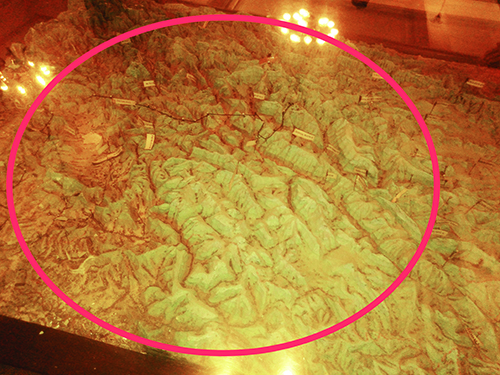news details |
|
|
| Stoneware map of erstwhile Dogra kingdom in tatters at Jammu Amar Mahal | | |  EARLY TIMES REPORT EARLY TIMES REPORT
JAMMU, Dec 27: The outline map showcasing the great Dogra kingdom made of stoneware and placed in Jammu’s Amar Mahal is in dilapidated condition for long, leaving the visitors confused due to the flaglets torn and misplaced in entirety.
In the main hall of Jammu’s Amar Mahal- a magnificent historic building overlooking the Jammu city, a map made of stoneware of the erstwhile kingdom of Jammu and Kashmir ruled by the Dogra Royal dynasty is housed. This green colour tinted stoneware map used to have flaglets depicting various provinces and regions of the kingdom like Gilgit-Baltistan, Muzaffarabad, Ladakh, Rajouri, Jammu, Kashmir Valley, Doda and other places. The visitors of the museum usually used to get a glimpse into the past and would know how magnificent the Dogra kingdom really was.
However, at present, as one peeks through this stoneware map, one astonishingly finds most of the flaglets torn and the map in dilapidated condition, revealing nothing and on the contrary confusing the history loving people.
The museum was inaugurated by the Indira Gandhi, Prime Minister of India, on 13 April 1975. To promote the stated objectives, the Trust arranges guided tours, book readings, lectures, film shows and hobby classes and other visitor friendly activities in the Museum. Scholarly exchanges, workshops and exhibitions are also regular features held by the Trust. The Dogra-Pahari paintings displayed in the museum were creation of the second half of the 18th century in Jammu and Himachal Pradesh of the Kangra School of Art. To quote the words of Karan Singh: "The whole effect is to transport one into a fascinating miniature world with its own aura and ethos.
An exclusive chamber in the museum, once the living quarters of the Maharani (later called the Maharajmata) Tara Devi, is conserved and exhibited in its original form where a silver bedspread, period furniture, photographs, the decoration of the Crown of India which was presented to her in 1945, her personal items of clothing and the unique Victorian bath room are on display.
It is noteworthy to mention here that the Amar Mahal palace is a red sandstone structure with red bricks in a picturesque environment on a hillock overlooking the Tawi river valley. Built in the European castle style, the palace has sloping roofs with turrets and tall towers. When built during the reign of Raja Amar Singh, it was the tallest building in Jammu. The imposing building has long passages on three sides, which are covered by sloping corrugated tin roofs. The passages are supported on columns with wooden framework. The first floor of the palace building has French windows with a connected balcony. The top floor has a bay window. The windows also depict triangular projections in classical Greek architectural style, which are fitted over ornate false columns. |
|
|
|
|
|
|
|
|
|
|
|
|
| |
| |
|
|
|
|
 |
|
|
|
|
STOCK UPDATE |
|
|
 |
| BSE
Sensex |
 |
| NSE
Nifty |
|
|
| |
CRICKET UPDATE |
|
|
|
|
|
| |
| |
|
|
| |
|
|
|
|
| |
|
|
|
|
|
|
|
|
|
|
|
|
|
